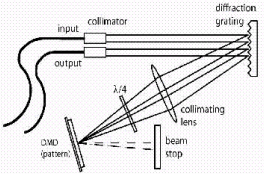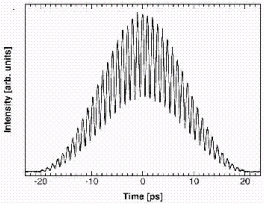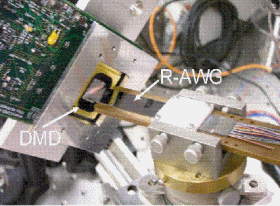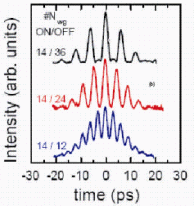Generation of Arbitrary Sequences of Ultrafast Pulses
A. Bernussi, L. Grave de Peralta, and H. Temkin

Schematics of the FT-PS approach.

An output sequence obtained with FT-PS with terahertz pulse separation within the burst.
Femtosecond pulse shaping is of considerable interest for a variety of applications in areas extending from high-speed communications to biological processes. At the Nano Tech Center we have been investigating two different approaches to generate arbitrary sequences of ultrafast pulses.
Reconfigurable Fourier-transform pulse shaper (FT-PS): This technique uses a diffraction grating and an array of digital micromirror device (DMD) as a spatial modulator. By adjusting the on/off state of individual micromirrors or in groups we can select dispersed spectral components. Advantages of this approach include superior spatial resolution, established high reliability, fast reconfigurability and flexibility, control of the burst length, number of pulses, and pulse separation within the burst. With this approach we have been able to demonstrate arbitrary sequences with terahertz pulse separation within the burst.

Experimental DST-PS.

Output sequence from an R-AWG with grating waveguides.
Reconfigurable direct space-to-time pulse shaper (DST-PS): This approach is based on the combination of a reflective arrayed waveguide grating (R-AWG) multiplexer and an array of digital micro-mirrors used as the external reflector. This method offers low-loss, fast reconfigurability and considerable footprint advantage over its equivalent bulk optics approach. Spatial modulation was obtained by imposing a periodic structure on the digital micro-mirror array. The period of this structure and the number of reflecting micromirrors within each period was varied to produce pulse sequences with variable repetition rates within the burst and different pulse widths.
Research support: NSF
Nano Tech Center
-
Address
Texas Tech University | Whitacre College of Engineering -
Phone
806.742.3533 -
Email
webmaster.coe@ttu.edu
